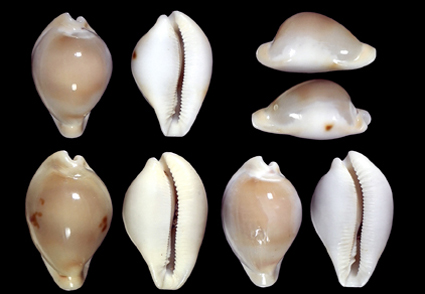Abstract
Based on molecular and conchological features, a new genus, Bouchetaria, is proposed for the Cypraeidae species Nesiocypraea aenigma Lorenz 2002. Molecular analysis of cox1 and 16S genes places Bouchetaria within a monophyletic group—composed of the genera Propustularia, Nesiocypraea, Ipsa, Perisserosa, Cryptocypraea, and Nucleolaria—appearing as the sister group to all other living Cypraeidae. This group corresponds to the Erosariinae (sensu Lorenz & Hubert, 1993). The cox1 pairwise genetic distances between Bouchetaria aenigma and its closest taxa, Propustularia surinamensis and Nesiocypraea teramachii correspond to 15% and 17% difference, respectively. Morphologically, the sole species of the genus Bouchetaria differs from other Erosariinae genera by the near absence of darker color pattern, and denser and longer dentition, which extends onto the labrum and towards the base, where it forms branches. These morphological characters justify the edification of a new genus: Bouchetaria. Consistent with its multispiral protoconch, Bouchetaria aenigma has a fairly wide range in the deep-sea of the Mozambique Channel, from the northern coast of Kwa-Zulu Natal, South Africa, to the northern tip of Madagascar and the Glorioso Islands.
References
- Bridges, R.J. & Lorenz, F. (2013) A revised morphometric formula for the characterisation of cowries (Gastropoda: Cypraeidae). Conchylia, 43, 3–16.
- Castelin, M., Puillandre, N., Kantor, Y.I., Modica, M.V., Terryn, Y., Cruaud, C., Bouchet, P. & Holford, M. (2012) Macroevolution of venom apparatus innovations in auger snails (Gastropoda; Conoidea; Terebridae). Molecular Phylogenetics and Evolution, 64, 21–44. https://doi.org/10.1016/j.ympev.2012.03.001
- Dolin, L. & Lozouet, P. (2004) Nouvelles espèces de gastéropodes (Mollusca: Gastropoda) de l’Oligocène et du Miocène inférieur de l’Aquitaine (Sud-Ouest de la France). Partie 3. Cypraeidae et Ovulidae. Cossmanniana, 4, 1–164.
- Drummond, A.J., Suchard, M.A., Xie, D. & Rambaut, A. (2012) Bayesian phylogenetics with BEAUti and the BEAST 1.7. Molecular Biology and Evolution, 29, 1969–1973. https://doi.org/10.1093/molbev/mss075
- Fehse, D. (2010) New species of fossil Cypraeoidea from Europe and Australia (Mollusca: Gastropoda). Palaeontographica, Abteilung A, 292, 1–19. https://doi.org/10.1127/pala/292/2010/1
- Folmer, O., Black, M., Hoeh, W., Lutz, R. & Vrijenhoek, R. (1994) DNA primers for amplification of mitochondrial cytochrome c oxidase subunit I from diverse metazoan invertebrates. Molecular Marine Biology and Biotechnology, 3, 294–299.
- Iredale, T. (1930) Queensland molluscan notes, No. 2. Memoirs of the Queensland Museum, 10, 73–88. [https://www.biodiversitylibrary.org/page/52]
- Lanfear, R., Calcott, B., Ho, S.Y. & Guindon, S. (2012) PartitionFinder: combined selection of partitioning schemes and substitution models for phylogenetic analyses. Molecular Biology and Evolution, 29, 1695–1701. https://doi.org/10.1093/molbev/mss020
- Liltved, W.R. (1989) Cowries and their relatives of southern Africa. Seacomber Publications, Cape Town, 208 pp., 298 figs. + numerous unnumbered figs.
- Lorenz, F. (2002) New worldwide cowries. Descriptions of new taxa and revisions of selected groups of living Cypraeidae (Mollusca: Gastropoda). Schriften zur Malakozoologie aus dem Haus der Natur-Cismar, 20, 1–292.
- Lorenz, F. (2017) Cowries. A Guide to the Gastropod Family Cypraeidae. Vol. 1. ConchBooks. Harxheim, 644 pp.
- Lorenz, F. & Hubert, A. (1993) A guide to worldwide Cowries. Verlag Christa Hemmen, Wiesbaden, 66 pp.
- Meyer, C.P. (2004) Toward comprehensiveness: Increased molecular sampling within Cypraeidae and its phylogenetic implications. Malacologia, 46, 127–156.
- Minh, B.Q., Nguyen, M.A.T. & von Haeseler, A. (2013) Ultrafast approximation for phylogenetic bootstrap. Molecular Biology and Evolution, 30, 1188–1195. https://doi.org/10.1093/molbev/mst024
- Palumbi, S.R. (1996) Nucleic acids II: the polymerase chain reaction. In: Hillis, D.M., Mable, B.K. & Moritz, C. (Eds.), Molecular systematics. Sinauer Associates, Sunderland, Massachusetts, pp. 205–247.
- Schilder, F. (1930) Beitrage zur Kenntnis der Cypraeacea (Moll. Gastr.). III. Zoologischer Anzeiger, 92, 67–78.
- Schilder, F.A. (1928) Die Cypraeacea des Daniums von Dänemark und Schonen. Danmarks Geologiske Undersøgelse, 2, 1–27. https://doi.org/10.34194/raekke4.v2.6973
- Tamura, K., Peterson, D., Peterson, N., Stecher, G., Nei, M. & Kumar, S. (2011) MEGA5: molecular evolutionary genetics analysis using maximum likelihood, evolutionary distance, and maximum parsimony methods. Molecular Biology and Evolution, 28, 2731–2739. https://doi.org/10.1093/molbev/msr121
- Trifinopoulos, J., Nguyen, L.-T., von Haeseler, A. & Minh, B.Q. (2016) W-IQ-TREE: a fast online phylogenetic tool for maximum likelihood analysis. Nucleic Acids Research, 44, W232–W235. https://doi.org/10.1093/nar/gkw256
- von Schlotheim, E.F. (1820) Die Petrefactenkunde auf ihrem jetztigen Standpunkte durch die Beschreibung seiner Sammlung versteinerter und fossiler Überreste des Thier- und Pflanzenreichs der Vorwelt. Becker, Gotha, LXII + 437 pp.


